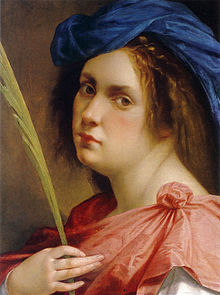List of 999 women of the Heritage Floor / Artemisia Gentileschi
This list describes the place setting for Artemisia Gentileschi on the table of Judy Chicago's art installation The Dinner Party . It is part of the list of 999 women on the Heritage Floor who are assigned to the respective place settings on the table. The names of the 999 women are on the tiles of the Heritage Floor, which is arranged below the table and belongs to the art installation.
description
The installation consists of a three-sided table, each with 13 historical or mythological personalities, thus a total of 39 people, from prehistory to the women's rights movement . These people were assigned a place setting at the table, consisting of an individually designed table runner, an individually designed plate, a goblet, knife, fork, spoon and serviette. The first page of the table is devoted to prehistory up to the Roman Empire , the second to Christianization up to the Reformation and the third from the American Revolution to the women's movement. Each place setting on the table is assigned additional personalities who have received an entry on the tiles of the Heritage Floor, which occupies the space under the table and the center of the space between the sides of the table. This list includes the personalities assigned to the Artemisia Gentileschi table setting. Your seat is on the second side of the table.
Hints
In addition to the names as they are used in German transcription or in scientific usage, the list shows the spelling chosen by Judy Chicago on the tiles.
The information on women who do not yet have an article in the German-language Wikipedia is referenced by the individual references listed under comments . If individual information in the table is not referenced via the main article, additional individual references are given at the relevant point. If there are any discrepancies between the information provided in Wikipedia articles and the descriptions of the work of art on the Brooklyn Museum website , this will also be indicated under Comments.
Place setting for Artemisia Gentileschi
Artemisia Gentileschi was born in Rome on July 8, 1593. Her father was the painter Orazio Gentileschi and her mother Prudentia Montone, who died in 1605. She was taught painting by her father, for whom she also stood as a model. This strongly influenced her style. To learn the art of perspective, her father sent her to see his colleague and friend Agostino Tassi , who raped Artemisia. Then he blackmailed her with a promise of marriage, which he did not keep, which made her socially impossible. Orazio Gentileschi sued him in May 1612. During the trial, Artemisia had totestifyunder torture with the thumbscrew and was examined in a degrading gynecological examination to prove that she was not a prostitute, as Tassi had claimed to get out of the affair pull. Tassi was convicted, but this, too, did not fully restore Artemisia's reputation. Even her wedding to the Florentine painter Pietro Antonio di Vicenzo Stiattesi, which took place shortly afterwards, could not do this. Artemisia moved to Florence , where her daughter was born. In 1615 she receivedher first major commissionfrom Michelangelo Buonarroti the Younger , a great-nephew of Michelangelo , and in 1616 she received the honor of being the first woman to beaccepted intothe Accademia dell'Arte del Disegno .
Artemisias fame increased and she worked a lot for the Medici family , where she was particularly encouraged by Cosimo II . Her style evolved and she moved away from the way her father painted. Her best-known work Judith Beheaded Holofernes was created around 1620. Artemisia dealt strongly with the biblical legend and in her version Judith is a cold-blooded murderer and the painting is characterized by an extremely realistic representation. She was able to return to Rome with her two daughters in 1623, where she had several clients, including Cardinal Francesco Barberini , nephew of Pope Urban VIII , and Commendatore Cassiano dal Pozzo . However, the most important city in Europe and three times the size of Rome was Naples and Artemisia moved there in 1630. Her workshop in Naples flourished, and she earned higher fees than her male colleagues. She received an invitation to London to the court of King Charles I , where her father was now a court painter, in 1635. It was probably not until 1637 that she accepted the invitation and supported her father Orazio in designing the ceiling painting in the Queen's House in Greenwich . The following year her father died in England and Artemisia returned to Naples. There she received great support from the patron Antonio Ruffo of Messina. However, her last years of life were marked by health problems and financial difficulties and she died around 1652/53.
The place setting for Artemisia Gentileschi on the dinner table is based on the motif of her most famous picture, Judith beheading Holofernes . The colors of the picture form the basis for the setting of the dinner table. The painting of the dish plays with the light-dark technique of painting in the time of Baroque was popular and played on the painting style of Caravaggio , a prominent painter of this style, named Caravaggism . Artemisia, like her father, are considered to be the most famous painters who created their work in this style. The rotated shapes on the plate should indicate the efforts, the "turning and turning" that a woman had to make at the time to become an artist. The plate is placed on a dark fabric, which is decorated with a repeating pomegranate motif in the baroque style and is intended to indicate their time. The plate is surrounded by a lush, velvety gold fabric, which is kept in the color that Artemisia liked to use in her paintings and is known under the name "Artemisia Gold". According to Chicago, the fabric almost envelops the plate and is said to provide a safe, protective environment that Orazio Gentileschi wanted to create for his daughter. The front and back of the table runner are modeled on "bizarre silk". This style involves laying multiple patterns on top of each other to create a repeating design. The back is created on a dark background and the front on a light background. On the front is the name with the decorated initial letter "A". It is pierced by a sword, which points to Judith and is supposed to indicate the physical and emotional strength of each woman, and is decorated with a color palette and four brushes, what for the artist is standing.
| Surname | Spelling on the tile | Date of birth | cultural spatial assignment | Remarks | image |
|---|---|---|---|---|---|
| Adélaïde Labille-Guiard | Adélaïde Labille-Guiard | 1749 | Kingdom of France | Classicist painter and founder of the first Parisian women's school for painters . |
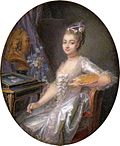
|
| Angelika Kauffmann | Angelica Kauffman | 1741 | Switzerland , Archduchy of Austria | Painter of Classicism . |

|
| Catarina van Hemessen | Caterina Van Hemessen | 1527 or 1528 | Antwerp | Renaissance painter. She was a member of the Antwerp Guild of Saint Luke. |
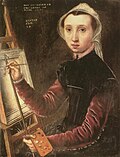
|
| Elisabeth Sophie Chéron | Elizabeth Cheron | 1648 | Kingdom of France | Portraitist, poet and translator. She later switched to making copperplate engravings and ran a literal salon . |
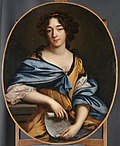
|
| Elisabeth Vigée-Lebrun | Elizabeth Vigeé-Lebrun | 1755 | Kingdom of France | Painter who made numerous portraits of European nobles. Her works can be assigned to classicism . |

|
| Elisabetta Sirani | Elisabetta Sirani | 1638 | Bologna | Painter and engraver . She founded an art academy for girls and women only in Bologna and was one of the first women ever to be accepted as a member of the renowned Accademia di San Luca in Rome. |

|
| Elizabeth Farren | Elizabeth Farren | around 1759 | England | English actress. |

|
| Fede Galizia | Fede Galizia | 1578 | Duchy of Milan | Renaissance painter, a pioneer of still life. | |
| Joanna Koerten | Joanna Koerton | 1650 | Netherlands | Artist who excelled in painting, drawing, embroidery, glass etching and wax modeling. She gained fame as a maker of silhouettes . |
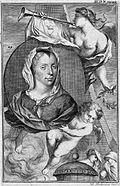
|
| Judith Leyster | Judith Leyster | 1609 | Netherlands | She is considered one of the few painters of the Golden Age whose work has survived to this day. Her work is assigned to the baroque . |
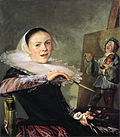
|
| Lavinia Fontana | Lavinia Fontana | 1552 | Bologna | Painter of Mannerism , in the 1570s an important portraitist of Bologna. She was elected to the Academy of Rome. |

|
| Leonora Baroni | Leonora Baroni | 1611 | Duchy of Mantua | Singer , musician and composer . |

|
| Levina Teerlinc | Levina Teerling | 1510/1520 | England | Painter, daughter of the miniaturist Simon Bening , emigrated to England in 1545 , where she was court painter at the English royal court until her death . | |
| Luisa Roldan | Luisa Roldain | 1652 | Kingdom of Spain | First female sculptor documented in Spain. | |
| Luísa Todi | Luiza Todi | 1753 | Kingdom of Portugal | Opera singer . |
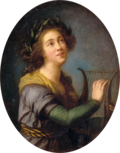
|
| Marguerite Gerard | Marguerite Gerard | 1761 | Kingdom of France | Painter and etcher , her works can be assigned to classicism . |

|
| Maria de Abarca | Maria de Abarca | † around 1656 | Kingdom of Spain | Painter , worked in Madrid in the middle of the 17th century and was also active as a poet. Their miniatures and portraits in particular were widely recognized. | |
| Maria Sibylla Merian | Maria Sibylla Merian | 1647 | Holy Roman Empire , Republic of the Seven United Provinces | Natural scientist and artist, belongs to the younger Frankfurt line of the Merian family in Basel , her work Metamorphosis insectorum Surinamensium is an important pioneer of modern entomology . |
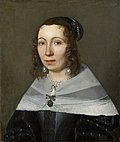
|
| Marie Champmeslé | Marie Champmeslé | 1642 | Kingdom of France | Actress, wife of Charles Chevillet . |
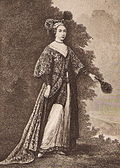
|
| Marie Vernier | Marie Vernier | around 1590 | Kingdom of France | Actress, leading actress and co-director of the Valleran-Lecomte theater group that performed at the Hôtel de Bourgogne , the first Parisian actress known by name. | |
| Nell Gwyn | Nell Gwyn | 1650 | England , Scotland | Actress and the most popular among the English people of the many mistresses of the English King Charles II. |

|
| Onorata Rodiani | Honorata Rodiana | 1403 | Duchy of Milan | Painter and Condottiere . | |
| Properzia de 'Rossi | Properzia de Rossi | around 1490 | Bologna | Sculptor of the Italian Renaissance . |

|
| Rachel Ruysch | Rachel Ruysch | 1664 | Netherlands | Still life painter of the Baroque . |

|
| Rosalba Carriera | Rosalba Carriera | 1675 | Republic of Venice | Pastel - painter , her works are in the spirit of the Rococo created and are characterized by their softness of color and great grace. |

|
| Sabina von Steinbach | Sabina Von Steinbach | N / A | Alsace | According to legend, a Steinmetzin the Gothic . Said to have worked on the Strasbourg Cathedral . |

|
| Sarah Siddons | Sarah Siddons | 1755 | Wales | One of the greatest tragic actresses of her time in English theater. |

|
| Sofonisba Anguissola | Sophonisba Anguisciola | around 1531/1532 | Duchy of Milan | Painter of the Renaissance and the most successful artist of this era. |
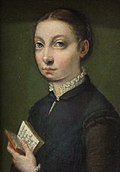
|
- Individual evidence
- ^ Brooklyn Museum: Artemisia Gentileschi. In: brooklynmuseum.org. Retrieved October 27, 2019 .
- ↑ Brooklyn Museum: Joanna Koerton. In: brooklynmuseum.org. Retrieved October 27, 2019 .
- ↑ Brooklyn Museum: Luisa Roldain. In: brooklynmuseum.org. Retrieved October 27, 2019 .
- ↑ Brooklyn Museum: Marie Champmeslé. In: brooklynmuseum.org. Retrieved October 27, 2019 .
- ^ Brooklyn Museum: Marie Venier. In: brooklynmuseum.org. Retrieved October 27, 2019 .
- ↑ Brooklyn Museum: Honorata Rodiana. In: brooklynmuseum.org. Retrieved October 27, 2019 .
Web links
- Brooklyn Museum, Artemisia Gentileschi
- The Dinner Party on the website of Through the Flower , Judy Chicago's non-profit organization
